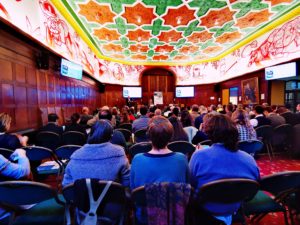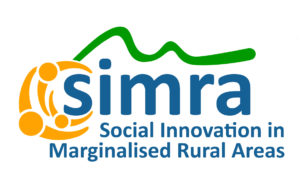 Since starting in 2016, the Horizon 2020 project “Social Innovation in Marginalised Rural Areas” (SIMRA) has been at the forefront of promoting the contribution of social innovation to social, economic and environmental development in disadvantaged rural areas. As a transdisciplinary research project, SIMRA has managed to address numerous facets of the current global context such as the United Nations Sustainable Development Goals, the Paris Agreement, the Convention on Biological Diversity, the reform of the Common Agricultural Policy, etc. and to make its research relevant in the real world.
Since starting in 2016, the Horizon 2020 project “Social Innovation in Marginalised Rural Areas” (SIMRA) has been at the forefront of promoting the contribution of social innovation to social, economic and environmental development in disadvantaged rural areas. As a transdisciplinary research project, SIMRA has managed to address numerous facets of the current global context such as the United Nations Sustainable Development Goals, the Paris Agreement, the Convention on Biological Diversity, the reform of the Common Agricultural Policy, etc. and to make its research relevant in the real world.
SIMRA organised its final conference in Brussels on 19 and 20 February 2020. During the final conference, many of the project’s main findings were presented and their implications for policy at all levels (EU, national, regional and local) were discussed, including for the next EU programming period 2021 to 2027.
Rural areas – a fertile breeding ground for social innovation
SIMRA has explored vibrant examples of community-led projects to identify the triggers and drivers, development patterns, factors of success and evaluation criteria for social innovation in rural areas.
Several local stakeholders came to present their projects during the conference:
- Forest Defense Groups (ADFs in Catalan) in Catalonia, Spain. ADFs were officially created in the 1980s and are associations formed by forest owners, agricultural and environmental associations, and municipalities to work on wildfire prevention, surveillance and first response to forest fires, as well as to reafforest affected areas within their territories. Their success is partly due to the strong linkages with their territory and its customs and traditions, and their example is now being transferred from rural to urban contexts in Catalonia.
- The Growing Club in Lancashire and Cumbria, UK. The Growing Club provides an alternative model for business training and coaching of women entrepreneurs coming from socially disadvantaged backgrounds. Three back-to-back courses have been set up for the women: the Sowing Club which is a pre-start up courses for women; Roots and Shoots which is a start-up course for those ready to start a small business; and the Bloom and Grow programme which is designed with coaching and support structures to help significantly grow small businesses. This initiative empowers women by alleviating them from poverty and becoming independent from government subsidies, thus improving the local economy and enabling the social integration of vulnerable women and their families into society.
This diversity was illustrated through the presentation of SIMRA’s database of social innovations in rural areas, one of the main outputs of the project. Information on more than 300 social innovations has been collected, covering a variety of topics, forms, and target groups. Through this work, the SIMRA project has demonstrated that social innovation can be a vital ingredient for addressing rural challenges such as outmigration, diversification of rural businesses, climate change, changing lifestyles, inclusiveness and the restructuring of rural economies.
What are the drivers and enablers of rural social innovations?
Much of the social innovation process is made up of capacity-building at the local level and co-learning of actors in policy, practice and research, in order to engage and empower local communities and to enhance societal well-being. The SIMRA project studied the social innovation process through 7 Social Innovation Actions, which are a new way of collaborating between research and practice, and 24 Case Studies. SIMRA identified several major needs for social innovators to succeed, noted below:
- Time and opportunity: to structure reflection, to work around volunteer timetables, to allow for an iterative learning process;
- Leadership, coordination and commitment: building relationships and a working group, sharing responsibilities, developing a shared vision, managing risks and conflicts;
- Skills: bridging local and external knowledge to design and implement the social innovation, ensuring sufficient information exchanges and networking to build social capital;
- Finance: for seed money and operational support, without burdening the community;
- Supportive environment: through integrated and flexible legal frameworks at all scales, and through political recognition of the benefits of the social innovation.
How do European policies support social innovation?
Over the past four years, SIMRA has explained to policy makers the potential that social innovation offers. Although social innovations may happen as a result of citizen action alone, its prospects of success and its impact can be significantly enhanced by the design of supportive policies. SIMRA’s final policy messages stem from the analysis of EU and national policies through a sectoral (e.g. social care), structural (e.g. CAP measures, such as LEADER), and institutional (e.g. legislation on associations and cooperatives) lens. They illustrate the importance, breadth and scope of social innovation and how it can be recognised more effectively in policies. The key concepts associated with social innovation, as identified by SIMRA (innovation ecosystem, social capital, niche development, and creativity) benefit from an enabling policy framework that empowers social innovators in rural areas to take action with minimum risk-taking, thus providing local solutions to local challenges. SIMRA’s nine key messages for the policy community can be accessed in our final policy brief “How policy can help bring about social innovation in rural areas”.
Social innovation has increasingly been contributing to achieving policy objectives in the overall approach of the European Commission to emerging socio-economic problems. Indeed, the European Pillar of Social Rights was enacted in November 2017. It sets out guiding principles of equal access to the labour market, fair working conditions and appropriate sustainable social protection. The human capital aspect of this policy was reinforced in the recent communication “A Strong Social Europe for Just Transitions”. Resources allocated to social innovation to mainstream policy innovations and scale-up successful experiences are being channelled through the European Social Fund (ESF) and the Programme for Employment and Social Innovation (EaSI). Several calls have been launched over recent years by DG EMPL to directly support social innovation initiatives in the EaSI Participating Countries.
According to DG AGRI, next Common Agricultural Policy 2021-2027 will also strive to create such an impact through political engagement, awareness-raising activities, interventions, simplified procedures and financial support. This is being communicated to the Member States through negotiations over the CAP Strategic Plans. Possible interventions to be included in the Strategic Plans to support social innovation are: facilitating cooperation (LEADER, EIP-AGRI, Smart Villages), roll-out of broadband, provision of training and advisory services, establishment of networking (CAP Networks), enabling peer-to-peer learning, creating opportunities for young farmers and new entrants to farming and rural business start-ups, and investments in supportive infrastructure. However, there is also a need for more flexibility in measures to support innovation in non-agricultural activities.
Take-away messages and future perspectives
The new policies being prepared for 2021-2027 offer prospects of support for social innovation. Notable amongst these will be through the CAP and its opportunities for a smart mix of support measures, and through the European Social Fund to support the development of skills and social inclusion. Social innovation is also reflected in the new set of European Commission priorities embedded in the Green Deal, an action plan for the social economy, a digital strategy fit for the future, and the guiding principles of leaving no one behind. Based upon the evidence produced by the SIMRA project, rural communities have a lot to offer the planned long-term vision for rural areas through social innovation.
Useful links
 Presentations, report and photographs of the conference
Presentations, report and photographs of the conference- Database of examples of social innovation
- “Social Innovation: A Practice guide”
- Policy brief “How policy can help bring about social innovation in rural areas”
- SIMRA Innovation Action participatory videos
- SIMRA project deliverables
- SIMRA’s collections of good practices (case studies, rural services, Balkans, mountain areas, Innovation Actions, Green Deal)










